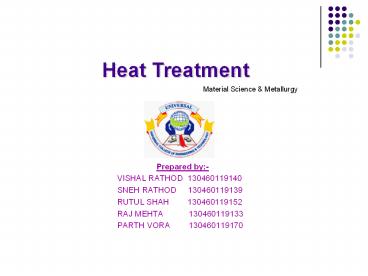Prepared by:- PowerPoint PPT Presentation
1 / 26
Title: Prepared by:-
1
Heat Treatment
Material Science Metallurgy
- Prepared
by- - VISHAL RATHOD
130460119140 - SNEH RATHOD
130460119139 - RUTUL SHAH
130460119152 - RAJ MEHTA
130460119133 - PARTH VORA
130460119170
2
Heat Treatment
3
Heat Treatment
- The amount of carbon present in plain carbon
steel has a pronounced effect on the properties
of a steel and on the selection of suitable heat
treatments to attain certain desired properties.
Below are some major types of heat treatment
processes
4
Types
- Annealing
- Normalizing
- Hardening
- Carburizing
- Tempering
5
Annealing
- Makes a metal as soft as possible
- Hypoeutectoid steels (less than 0.83 carbon) are
heated above upper critical temp., soaked and
cooled slowly. - Hypereutecoid (above 0.83) are heated above
lower critical temp., soaked and allowed to cool
slowly.
6
- Process Annealing. Low carbon steels may harden
through cold working. They can be heated to
around 100 degrees below lower critical temp.,
soaked and allowed to cool in air. - Spheroidising. High carbon steels may be annealed
just below the lower critical temp. to improve
machinability.
7
(No Transcript)
8
- Normalising. Internal stresses caused by rolling
and rolling or forging are removed. Steels are
heated above upper critical temp., soaked and
cooled in air. The cooling rate is faster than
annealing giving a smaller grain structure. - Stress relieving. The component is reheated and
held at temperature for a period of time and
cooled slowly.
9
(No Transcript)
10
Hardening
- Medium and High carbon steels (0.4 1.2) can be
heated until red hot and then quenched in water
producing a very hard and brittle metal. At 723
degrees, the BCC ferrite changes into Austenite
with a FCC structure.
11
Hardening 0.6 carbon steel
- The metal is heated to over 780 degrees, which
allows the carbon to dissolve into the FCC
Austenite. - Quenching the metal quickly in water prevents the
structure from changing back into BCC. - A different structure, Body Centre Tectragonal
(BCT) is formed. It is called Martensite and is
extremely hard and brittle with a needle-like
microstructure.
12
Case hardening
- Low carbon steels cannot be hardened by heating
due to the small amounts of carbon present. - Case hardening seeks to give a hard outer skin
over a softer core on the metal. - The addition of carbon to the outer skin is known
as carburising.
13
(No Transcript)
14
Tempering
- To remove some of the brittleness from hardened
steels, tempering is used. The metal is heated to
the range of 220-300 degrees and cooled. - Tempering colours are an indicator of temperature
on polished metals. Colours range from yellow to
brown to violet and blue.
15
Heat Treatments
- A Normalising
- B Annealing or Hardening
- C Spheroidising or Process Annealing
- D - Tempering
16
Quenching media
- Brine (water and salt solution)
- Water
- Oil
- Air
- Turn off furnace
17
Pack carburizing
- The component is packed surrounded by a
carbon-rich compound and placed in the furnace at
900 degrees. - Over a period of time carbon will diffuse into
the surface of the metal. - The longer left in the furnace, the greater the
depth of hard carbon skin. Grain refining is
necessary in order to prevent cracking.
18
- Salt bath carburizing. A molten salt bath (sodium
cyanide, sodium carbonate and sodium chloride)
has the object immersed at 900 degrees for an
hour giving a thin carbon case when quenched. - Gas carburizing. The object is placed in a sealed
furnace with carbon monoxide allowing for fine
control of the process. - Nitriding. Nitrides are formed on a metal surface
in a furnace with ammonia gas circulating at 500
degrees over a long period of time (100 hours).
It is used for finished components.
19
Induction hardening
- Induced eddy currents heat the surface of the
steel very quickly and is quickly followed by
jets of water to quench the component. - A hard outer layer is created with a soft core.
The slideways on a lathe are induction hardened.
20
Flame hardening
- Gas flames raise the temperature of the outer
surface above the upper critical temp. The core
will heat by conduction. - Water jets quench the component.
21
Age hardening
- Hardening over a period of time
- Also known as precipitation hardening
- Occurs in duraluminium which is an aluminium
alloy that contains 4 copper. This makes this
alloy very useful as it is light yet reasonably
hard and strong, it is used in the space
industry. - The metal is heated and soaked (solution
treatment) then cooled and left.
22
Pyrometry
- The measurement and control of temperature in a
furnace is called pyrometry.
23
Seger cones
- A traditional method of gauging furnace
temperature. - Cones with known melting temperatures are placed
in the furnace, temperature is identified as
cones collapse.
24
Optical pyrometer
- Also known as disappearing filament.
- The light intensity of a lamp, which can be
adjusted, is compared to the light from a
furnace. - Temperature is measured when the filament seems
to disappear in the glow from the furnace.
25
Thermo-electric pyrometer
- A thermocouple uses the principle that a small
current flows if two dissimilar metals are joined
in a loop with different temperatures at the
junctions. - A galvanometer at the cold junction detects a
change in current at the hot junction in the
furnace
26
Thank you.

